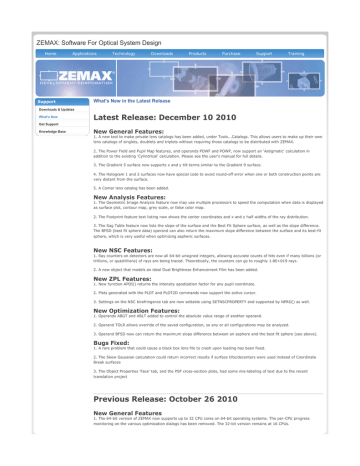


- ZEMAX DOWNLOAD OPTICS HOW TO
- ZEMAX DOWNLOAD OPTICS MANUALS
- ZEMAX DOWNLOAD OPTICS INSTALL
- ZEMAX DOWNLOAD OPTICS WINDOWS 10
ZEMAX DOWNLOAD OPTICS INSTALL
Follow the instructions in the quick start guide to download and install CADpass Client.Setting up CADpass Client for Use with OpticStudio SoftwareĬADpass Client is a CMC Microsystems’ license access client and is used by subscribers across Canada to connect to our secure license server(s).
ZEMAX DOWNLOAD OPTICS MANUALS
A PDF reader is required to open some of the tutorials and manuals included with the OpticStudio CAD program.Optimum hardware specifications and compatible operating systems are listed on the OpticStudio website.The following are examples of unacceptable login names: admin or administrator root super, sysadmin, user, owner, student, guest, temp, and system. You must have a unique login name (LINUX or Windows) that does not contain a blank space.You must have administrator rights for the computer on which you are installing this software.

ZEMAX DOWNLOAD OPTICS WINDOWS 10
This quick start guide provides instructions for installing OpticStudio Professional from Zemax LLC on a Windows 10 system using CMC Microsystem’s CADpass to access shared licenses on the CMC License Management System (LMS).
ZEMAX DOWNLOAD OPTICS HOW TO
For a pretty comprehensive look at how to perform the CAD Import, I’d recommend reading through the following articles on our Knowledgebase: How to import CAD objects.CADpass Client Secure Connection (will be referred to as CADpass Client or CADpass in this document) is a utility provided by CMC Microsystems that creates a secure connection between client PC’s, workstations, and computer sessions, and the CMC managed CNDN infrastructure. You can then import it into OpticStudio and place it in your system. However, as I mentioned above, I think the easiest way to go about defining this type of fiber will be to do so in an external CAD program like SolidWorks. If you’d like to explore this option, I’d recommend checking out our Polygon Object Help File at “The Setup Tab > Editors Group (setup tab) > Non-Sequential Component Editor > Non-Sequential Geometry Objects.” That is, you’d likely need to define vertex points and connect them with triangles over the entire surface of the fiber. That said, in terms of built-in objects, we do have the Polygon Object for you to get the taper, However, this approach would be extremely non-trivial, and would likely take quite a bit of computation/preparation on your part. You will likely want some help from an external CAD program. I don’t think that there is an easy way to model this type of Non-Sequential Component using only OpticStudio.


 0 kommentar(er)
0 kommentar(er)
